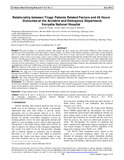| dc.contributor.author | Chelal, Daniel K. | |
| dc.contributor.author | Sum, Tecla J. | |
| dc.contributor.author | Morema, Everlyne N. | |
| dc.date.accessioned | 2023-10-25T12:04:40Z | |
| dc.date.available | 2023-10-25T12:04:40Z | |
| dc.date.issued | 2023-07-15 | |
| dc.identifier.uri | http://doi.org/10.47104/ebnrojs3.v5i3.288 | |
| dc.identifier.uri | https://www.ajol.info/index.php/ebnr/article/view/251029 | |
| dc.identifier.uri | http://ir-library.mmust.ac.ke:8080/xmlui/handle/123456789/2374 | |
| dc.description.abstract | Context: The goal of triage is to prioritize patients who require the most urgent care and increase efficiency when resources are insufficient to treat all patients as per their degree or grade of injury. An effective and efficient emergency center triage system should be able to sort both trauma and non-trauma patients according to the level of acuity and involves treatment as per the physiological parameters, either coded as red, orange, yellow, green, or black. Kenyatta National Hospital has adopted the South African Triage Score (SATS), which has proven effective in monitoring the patient's physiological parameters. It involves using a score form called triage early warning scores (TEWS). Emergency triage is an effective way to speed up the triage process, decrease waiting times, and boost patient outcomes in first-world nations. Low-income or limited-resource situations present unique obstacles that substantially affect the selection and application of the most suitable triage scale and the success of its implementation.
Aim: The objective of the study was to determine the relationship between triage patients related factors and 48 hours outcomes at the Accident and Emergency Department, Kenyatta National Hospital
Methods: The study was a cross-sectional study involving the triaged and coded patients flagged by scores using the Triage Early Warning Score (TEWS). A sample of 385 patients was from the accident and emergency department at Kenyatta National Hospital,
whereby a structured interview questionnaire and patient outcomes observation checklist were used.
Results: The study indicated that patient-related factors significantly influenced the management outcome of triaged patients' (t-statistic=0.210, p-value = 0.039 < 0.05).
Conclusion: It is, therefore, important to note that patient-related factors impact the outcome of triaged and coded patients in the accident and emergency department at Kenyatta national hospital. The hospital management reviews the triage process and policy to ensure that the patients can be followed up easily, using an online queue system guide, monitoring of the patient system, and subsequent follow-up that reduces waiting time. | en_US |
| dc.language.iso | en | en_US |
| dc.publisher | Evidence-Based Nursing Research | en_US |
| dc.subject | Relationship, Triage, Patients, Related, Factors, 48 Hours, Outcomes, Accident, Emergency, Department, , National, Hospital | en_US |
| dc.title | Relationship between Triage Patients Related Factors and 48 Hours Outcomes at the Accident and Emergency Department, Kenyatta National Hospital | en_US |
| dc.type | Article | en_US |

